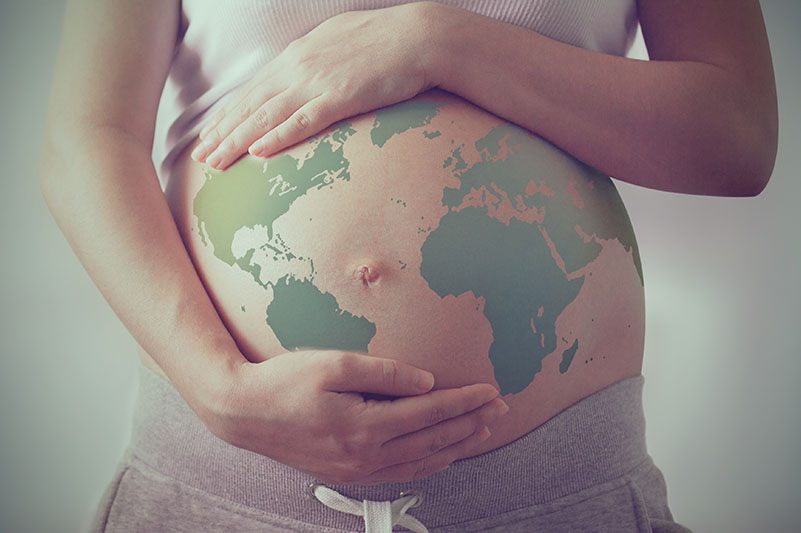According to data from the United States Department of Labor, there are 72 million women ages 16 and over in our country who are currently working or looking for work, accounting for 47 percent of the nation’s total labor force. In many other countries where women are an equally significant and important portion of the workforce, paid family leave is an integral part of encouraging workers to have families and successfully return to the workplace, but when women in the U.S. decide to have children, there is no such federal protection.
In today’s modern economy, the discussion of whether the government should expand federally-mandated parental leave is the subject of intense debate.
Current Policies and Protections: The USA vs. the World
As reported by the Pew Research Center, the U.S. is currently the only industrialized country that does not provide paid family leave to its citizens. The Bureau of Labor Statistics reports that only 16 percent of civilian workers had access to paid family leave (through their employers or under state and local government programs) in 2017.
This is in sharp contrast to other developed countries. When the Organization for Economic Cooperation and Development reviewed the paid maternity leave programs for 34 OECD countries and seven additional European Union countries, mothers in these countries are entitled to 17 weeks of paid maternity leave on average. EU leave policies mandate that each parent must be allowed to take at least 18 weeks of paid leave per child in its member countries. Further analysis reveals that 36 countries worldwide provide a year or more of paid maternity leave; indeed, new mothers in Finland are entitled to up to three years of paid leave, while Norwegian mothers get up to 91 weeks.
The International Labor Organization reports that the U.S. and Papua New Guinea are the only two countries in the world that mandate larger employers grant some form of parental leave but offer no related financial support of any kind.
The Family and Medical Leave Act(FMLA), signed in 1993, is the only federal leave legislation in the U.S. with the exception of temporary leave laws that were passed in response to the COVID-19 pandemic, which are discussed below. The FMLA guarantees workers 12 weeks of unpaid leave related to the care of a newborn or adopted child (as well as other medical conditions), protecting their right to return to their pre-leave position but making no provision for any financial assistance during their leave. Even this unpaid leave requirement only protects about 60 percent of employees; it fails to cover independent contractors, employees at companies with fewer than 50 employees, and many other workers.
In the wake of the COVID-19 pandemic, the United States issued limited provisions to assist parents in caring for children in limited circumstances. Federal laws, such as the Families First Coronavirus Response Act (FFCRA), have provided further rights to pregnant workers and new parents who get sick, must stay at home, lose their child care options, or need to care for ill loved ones. Under the Emergency Paid Sick Leave Act (contained within FFCRA and effective through December 31, 2020), employers with fewer than 500 employees were required to provide all employees with up to 80 hours of paid sick leave for certain qualifying coronavirus-related reasons.
Why Encourage Paid Family Leave?
Some fiscal conservatives argue that paid parental leave is just another undesirable, financially irresponsible government benefit. In response, many public health and policy experts assert that supporting paid family leave and backing working mothers is an investment in a country’s economy that can boost overall growth by enabling a full, robust, and competitive workforce.
Without a national paid leave policy, women may choose not to have a family at all, or to take minimal amounts of time off after childbirth, which can increase the health risks (and costs) for both themselves and their children. Experts have correlated longer maternity leave periods with reduced infant mortality rates, lowered illness and hospitalization rates, and benefits to women’s health generally.
The facts seem to bear this out. In 2010, the U.S. ranked 26th in infant mortality among the 29 OECD countries, behind most European countries as well as Japan, Korea, Israel, Australia, and New Zealand with 6.1 infant deaths per 1,000 live births (more than twice that of Japan and Finland). Research has also associated inadequate paid leave policies with higher incidences of mental health issues, including clinically diagnosable anxiety and depression among mothers, both during the postpartum period and later in life.
From the employer’s perspective, paid material leave makes good business sense. A recent report on paid family leave found that companies also benefit fiscally from offering this benefit since women who take paid leave are far more likely to return to the workforce and work longer hours one to three years later.
Private Employers and State Initiatives
The reality is that a majority of Americans support paid family leave – between 67 and 85 percent of the population according to Pew, depending on the specifics of the proposed leave policy. And 51 percent of respondents are in favor of federally-funded leave, while 48 percent supported private, employer-funded plans.
For private employers, paid leave can help them be more competitive in recruiting and retaining talent as well as promoting a healthy, happy workforce. Major tech employers like Google, Apple, Reddit, and Facebook have promulgated generous benefits packages, which include not only twelve weeks or more of paid parental leave but also add-ons like baby bonuses, child care credits, and subsidized fertility treatments. Some companies like American Express, the U.S. Division of Ikea, and Etsy even extend paid leave benefits to part-time and hourly workers. Unfortunately, although some workers now enjoy competitive benefits, the majority of U.S. workers still do not.
Where the federal government falls short, many states are picking up the slack. A few states – including California, Hawaii, Massachusetts, New Jersey, New York, Rhode Island, Washington, and the District of Columbia – have implemented programs to provide at least some paid parental leave benefits to their residents. California’s program, in effect since 2002, combines the state’s pre-existing disability insurance program with a paid family leave insurance program funded by a one percent tax on employees’ wages. It provides new parents with up to eight weeks of compensated family leave at 60 to 70 percent of their weekly salary (capped at approximately $1,300 per week). Last year, California also passed a bill that would significantly expand unpaid leave benefits (similar to those provided under the Family and Medical Leave Act) to employees who work for employers with 5 or more employees.
Whether spurred by free-market competition among private employers or increased governmental initiatives, the availability of paid parental leave will likely continue to expand. Employers and employees both will need to stay informed of the changes in their rights and requirements as these developments occur.

